Publications
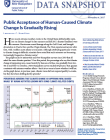
November 6, 2017
Have recent extreme weather events in the United States shifted public opinion on climate change? In late summer and fall 2017, disaster headlines were common. Hurricanes caused damage along the Gulf Coast, and brought devastation to Puerto Rico and the Virgin Islands. The West experienced severe wildfires, with 2 million acres aflame at one point. Although attributing particular events to…

November 27, 2017
In 2016, 12.4 percent of households reported Supplemental Nutrition Assistance Program (SNAP, or food stamps) receipt, down 0.4 percentage point from 2015. Similar declines in suburbs and cities drove the national decrease, but the 14.8 percent of rural households receiving SNAP did not significantly change between 2015 and 2016.
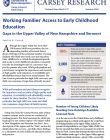
September 5, 2018
Although the Upper Valley has more than 200 licensed child care providers, the corresponding number of licensed slots is about 2,000 short of the estimated number of young children who likely need early care and education. Early childhood is a critical developmental period, and access to early childhood education is essential not only for learning but also as a necessary support for parents who…
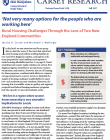
November 14, 2017
In this brief, we use interview and focus group data to describe some of the ways that restricted rural housing stock affects working families in two rural New England counties, and explore solutions proposed by rural residents and experts to make housing affordable (see Box 1 on page 2). Rural amenities and scenery make residence in certain New England regions desirable for second-home owners,…
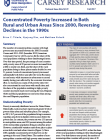
November 21, 2017
The number of nonmetropolitan counties with high poverty rates increased between the 2000 Decennial Census and 2011–2015 (hereafter 2013) American Community Survey (ACS), and so did the share of the rural population residing in these disadvantaged areas. Over this time period, the percentage of rural counties with poverty rates of 20 percent or more increased from a fifth to nearly one-third, and…
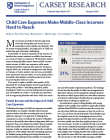
August 29, 2018
Most Americans believe that through hard work and saving they can secure an economically sound, middle-class lifestyle.1 But for many working families, the high price of child care makes this goal extremely challenging.
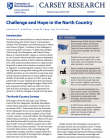
December 5, 2017
Hit hard by the national decline in natural-resource and manufacturing jobs, North Country communities in northern New Hampshire and bordering areas of Maine and Vermont (Figure 1) continue to face challenges in restructuring their economies.1 A 2008 study classified Coös County, New Hampshire, and Oxford County, Maine, as “amenity/decline” regions, a common pattern in rural America where…
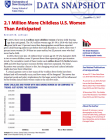
December 12, 2017
In 2016, there were 2.1 million more childless women of prime child-bearing age than anticipated. The 19.5 million women age 20–39 in 2016 who had never given birth was 12 percent more than demographers would have expected given child-bearing patterns just before the Great Recession. In 2016, there were 7 percent more women 20–39 than ten years earlier, but 22 percent more who had never had a…

December 15, 2017
Working families with young children face substantial barriers in accessing and affording quality child care. Figure 1 shows that among working families with a child under age 3, those who do not pay for child care are more likely to live in poor or low-income families than those who do pay for child care (61 percent versus 45 percent).
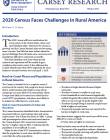
December 18, 2017
The 2020 Census will have ramifications for every person in the United States, urban and rural residents alike.1 Interest in the Census is growing2 and the Census Bureau’s plans are becoming more concrete,3 but little has been written about the special challenges that will make some rural areas and populations difficult to enumerate accurately.
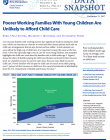
December 15, 2017
Low-income families with working parents face significant burdens paying for child care, which can function as a barrier to work and often means parents must rely on child care arrangements that are less formal and less stable.1 Amid national concerns about the high cost of child care, it is important to keep this issue at the forefront. Given the especially high costs of care for very young…
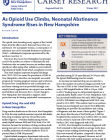
December 19, 2017
The opioid crisis besetting every region of the United States directly affects more than just those who use substances. For a pregnant woman, a consequence of substance use can be neonatal abstinence syndrome (NAS)—withdrawal symptoms experienced by the newborn (see Box 1).
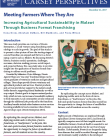
December 20, 2017
This case study provides an overview of Ziweto Enterprises, a social venture using franchising methodology to scale its growth. The goal of this study is to present a clear picture of how the starting stages of a social franchise can expand and thrive in a developing country such as Malawi. By discussing Ziweto’s history, business model, operations, challenges, successes, decision-making process…
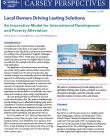
December 21, 2017
As outlined in the United Nations’ Sustainable Development Goals, there is an urgent need for mechanisms that effectively scale proven interventions for tackling some of humanity’s toughest challenges (United Nations 2015). While there are exemplary models that have proven to be highly effective, there are relatively few examples that have achieved large-scale replication.
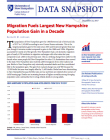
December 22, 2017
The population of New Hampshire grew by 7,800 between July of 2016 and July of 2017 to 1,343,000 according to new Census Bureau estimates. This is the largest population gain for the state since 2005 and 60 percent greater than last year, though it remains modest compared to gains in the 1980s and 1990s. Migration accounted for nearly all of the growth. New Hampshire had a net domestic migration…

February 13, 2018
The aging of the U.S. population is an ongoing trend. The U.S. Census Bureau projects that by 2050 one in every five Americans will be over 65, and that by 2060 the over-65 population will have doubled in absolute size and the over-85 population will have tripled. Life expectancy of a 65-year-old in 2014 compared to 1980 was 3.9 years longer for a man and 4.3 years longer for a woman.
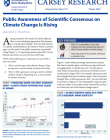
February 22, 2018
Among scientists who study the Earth’s climate, there is overwhelming agreement that humans are causing rapid change.1 Surveys find that the U.S. public underestimates the extent to which scientists agree on this point,2 but public awareness is gradually rising (Figure 1).
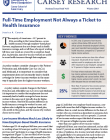
March 20, 2018
The majority of Americans—55.7 percent in 2016, according to the Census Bureau—access health insurance through employer-based plans.1 However, employment does not always result in health insurance coverage, and not all those who report working full time, year round are covered by an employer-based plan. In particular, many low-income workers are unable to access health insurance through their…
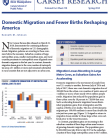
March 22, 2018
New Census Bureau data released on March 22, 2018, demonstrate the continuing influence of domestic migration on U.S. demographic trends. Migration patterns are reverting to those common before the recession. Suburban counties of large metropolitan areas, smaller metropolitan areas, and rural counties proximate to metropolitan areas all gained more domestic migrants in the last year. In contrast…
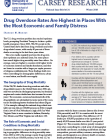
March 27, 2018
The U.S. drug overdose problem has reached epidemic levels, prompting President Trump to declare a public health emergency. Since 2000, 786,781 people in the United States have died from drug overdoses and other drug-related causes, with nearly 40 percent of those deaths occurring in the last three years alone.
